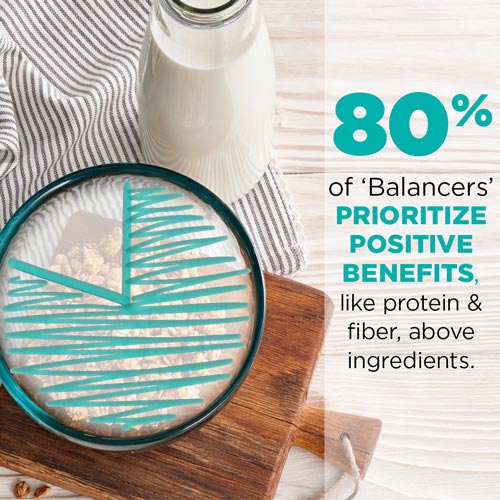
Clean Label Initiatives: Balancers Consumers Approach to Clean Labels
Filed Under: Best Practices, Market Research
C+R recently did a study to expose the attitudes and behaviors of consumers with differing approaches to clean labels. We then took this data and identified how brands can adapt their products and work to attract these different consumers. In this study, we asked consumers to rate their attitudes about food, nutrition and how they make their food choices across many different dimensions. We then statistically analyzed the results using Cluster Analysis to group consumers into segments. Among this national sample of 802 classifieds consumers, we can call 20% of consumers “Vigilant,” 15% “Balancers,” 47% “Keep it Simple,” and 17% “Not Bothered.” We’ve previously written on our Vigilant and Keep it Simple consumer segments and in the next blog post in our series, we look at our third consumer segment – Balancers.

Consumers who make up the Balancer segment take the popular “Everything in Moderation” approach concerning their food buying habits. While this mindset may seem almost clichéd, asignificant portion of consumers find using a balance mantra to be the most realistic and achievable strategic approach to clean labels and food choices overall. Nothing has to be verboten. Nothing has to be totally sacrificed. Nothing has to be simply good or evil. Think about some popular brands you see on grocery store shelves: Balance Bars, Earth Balance spreads, Balance Water, even Natural Balance Dog Foods. This exemplifies the notion of balance in our foods, and a balanced approach to eating resonates with many.
Balancers are also more likely than the other consumer segments to focus in on key “hot button” issues with regard to food labels. For example, when there is a High Fiber claim on the front of a package, the Balancer is likely to believe that this product is providing needed fiber and will taste good; so they don’t have to worry too much about checking the label to see if there are any ingredients that might detract from the product’s benefits. So, if a brand touts “A Good Source of Protein” on its label, that gives Balancers the needed confidence to buy that product and will more than likely keep them from feeling the need to scrutinize the ingredient label too closely. They focus on the positive and believe it will all work out in the end!
And at first glance, if they don’t see a hot button issue detailed on food packaging to provide them with an underlying benefit; they may check out an ingredient list with some interest. Even if there’s a “bad” ingredient in a food product, as long as negatives are kept to a minimum, the product can still fit their criteria for providing balance in their overall diet. When shopping, they are fine with throwing some clean products and other products that are less clean into their cart and will still feel good about the overall melting pot of their purchases. Think of these folks in line at a grocery store with lots of fresh fruits and vegetables, Annie’s Mac & Cheese, Kellogg’s Frosted Flakes, Flamin’ Hot Cheetos and two six packs of craft beer. You don’t have to have a squeaky clean label for Balancers to buy your product; appeal to their need for balance and you’ll make it into their carts.
explore featured
Case studies
